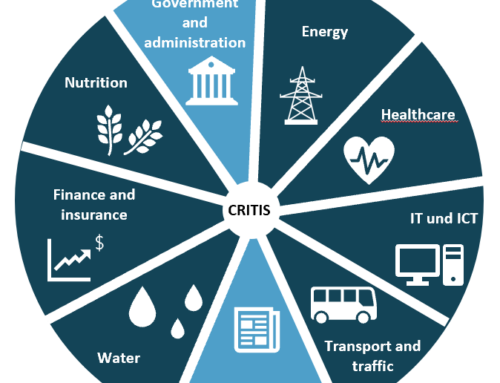If a group of people finds itself in an overwhelming situation, i.e. a situation where the challenge exceeds the available resources, the whole group may take refuge in a kind of cognitive emergency reaction. What a cognitive emergency reaction is, you can read in detail in the previous blog article Cognitive emergency response – the flight into familiar action – IUGITAS. However, here is a brief summary: a cognitive emergency response is a dysfunctional protective mechanism in which everything is done to maintain a sense of competence and self-worth. Often, inappropriately, the familiar and routinized behaviors are continued in order to maintain an apparent sense of competence to act as well as control.
When we talk about groupthink, we are not talking about swarm intelligence, but rather about the exact opposite of it. Groupthink does not mean that intelligent decisions are made on the basis of team collaboration, instead it means that the whole group acts in such a way that there is collective protection for the group’s sense of competence. The idea is to actively prevent conflict from occurring within the group, and decisions are made in a way that minimizes the potential for conflict. If groupthink occurs, it is even more problematic than an occurrence of a cognitive emergency response by an individual. A correction becomes very unlikely, since not only one individual is affected, whose behavior would be noticeable and can in theory be corrected by other persons.
But groupthink can also occur outside of overwhelming situations. It is also possible in everyday life that a group of people wants to maintain their own sense of competence through groupthink. That is why groupthink goes much further than a cognitive emergency response. Groupthink occurs in particular when there is a very high level of group cohesion or when the group acts in isolation or is very homogeneously composed, i.e. has a similar background and thus similar knowledge. Groupthink can occur unknowingly if no systematic methods are used for decision-making. In crisis teams, groupthink can especially occur when the crisis team leader drives a particularly strong, directive leadership style and the members of the crisis team want to experience security.
Irving Janis first studied and described groupthink in 1972. According to him, it is a complete assimilation of all individual opinions within the group into a common group opinion. The following eight symptoms are typical:
o Illusion of invulnerability
o Belief in the inherent morality of the group
o Collective rationalization of failures
o Out-of-group stereotypes
o Self-censorship
o Illusion of unanimity
o Direct pressure on dissenters
o Self-appointed mindguards
The latent goal of group thinking is to maintain the feeling of social competence. This is important so that the group has a sense of certainty of action and superiority over others, ultimately providing validation for its own actions. The illusion of invulnerability and the belief in the inherent morality of the group ensure that the above addressed goal is achieved. The collective rationalization of failure means that the group assumes that any occurrence of failure results from external circumstances and does not occur because of the group’s own inadequate planning or even wrong actions. Thus, the group attributes a victim role to itself and builds the opinion that a different action would also have led to the same outcome and that they have chosen the best possible path. As a result, the feeling of competence and superiority remains. In groupthink, non-group stereotypes are devalued, i.e. the impression prevails that one’s own group has a higher value compared to others. In this way, the group achieves that its actions are the best and its decisions are unchallengeable. Since the opinions of others are perceived as inferior, a kind of self-censorship develops, since just as in the cognitive emergency reaction, there is a resistance to criticism and comments coming from outside. All of this ensures that pressure is exerted on dissenters, and with it comes the illusion of unanimity. If groupthink occurs, dissenters are usually either excluded from the group or actively or passively persuaded not to voice criticism. The fact that this happens is also due to self-appointed mindguards. Mindguards are information filters that prevent deviations from the group consensus. These mindguards can either manifest themselves in a single person who filters the relevance of information, but equally this filtering can take place in the subconscious of all individuals, so that information that is actually relevant is classified as unimportant, since it would attack the sense of competence and thus contradict the latent goal of the group.
A well-known example of the fatal effects of groupthink is the Challenger space shuttle accident in 1986, where engineers knew about faulty parts on the space shuttle that ultimately caused the shuttle to fall apart shortly after launch and crash into the Atlantic Ocean at over 320 km/h. By excluding and suppressing people with relevant information about the seal rings that led to the accident, it was ensured that no concerns were raised about a launch recommendation and that the launch could proceed as planned. All of this was done to avoid negative press. In the end, it had an even worse outcome than a postponed launch could have had. Seven astronauts died in the space shuttle accident, and the space program was subsequently suspended for several years.
By not listening to concerns, other opinions, or criticism, the feeling of superiority and inviolability of one’s own group remains. If one considers what can happen in a work or project group when groupthink occurs, it quickly becomes clear that an occurrence in a complex situation can be even more dramatic. If a crisis team is affected by groupthink, this results, among other things, in plan optimism and a false assessment of the situation. Accordingly, no adequate action can take place. And the consequences can be dramatic. Therefore, it is even more important than in the case of the cognitive emergency reaction that the group actively tries to prevent groupthink from occurring. It helps to build a healthy group dynamic and to live an open error culture. It is also helpful to bring in external people to group meetings so that monitoring can take place and an objective picture can be maintained. The manager in particular should set a good example and be open to criticism and further suggestions for solutions. This also has the positive side effect that the group works more effectively. Irving Janis also suggests that small groups be formed to work on the same task, so that the same problem can be viewed from different perspectives. However, this can be problematic in crisis team work because an increased staff approach is needed and valuable time is lost.
If you want to test your capabilities or would like external moderation for your crisis teams, write to us!






